
Introduction
Nestled amidst the majestic Himalayas, Tibet reveals a world where ancient traditions and spiritual devotion intertwine. As I set foot in this sacred land, I was immediately drawn to its rich cultural history and the promise of spiritual awakening. The Shoton Festival is a vibrant celebration of Tibetan culture. The Thangka Pilgrimage is a journey of spiritual significance. Both events were the highlights of my visit. The Jokhang Temple and the Potala Palace, with their serene sanctuaries, offered a deeper understanding of a culture steeped in history, spirituality, and artistry.
Location
Lhasa, the capital city of Tibet Autonomous Region, is situated in the southwestern part of China. Nestled in the Himalayas at an altitude of approximately 3,650 meters (11,975 feet), Lhasa is one of the highest cities in the world. It lies on the banks of the Lhasa River, a tributary of the Yarlung Tsangpo River (Brahmaputra). Known as the “Place of the Gods,” Lhasa is a spiritual and cultural hub, home to significant Tibetan Buddhist sites, including the Potala Palace and Jokhang Temple. The city serves as the political, economic, and cultural center of Tibet, attracting pilgrims and tourists from around the globe.
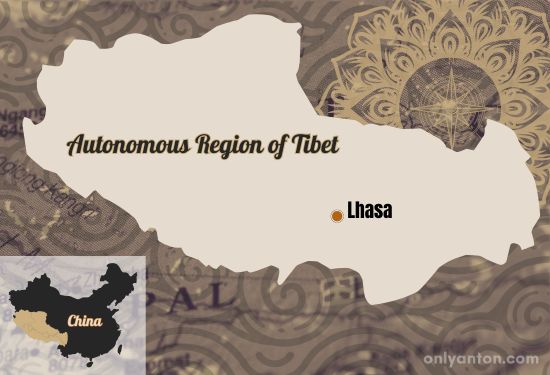
The Shoton Festival
In the heart of Lhasa, the Shoton Festival, or the ‘Yogurt Banquet,’ comes to life in the summer. In 2024, the Shoton Festival falls on the 4th of August. During a month-long period of retreat, the monks stay indoors to avoid treading on and killing newly emerged summer insects. The Shoton Festival marks the end of the monks’ seclusion. Historically, the laypeople would greet the monks with a banquet that featured yogurt.
The festival began in the 11th century. Celebrations now include horse racing, picnics, and the performance of local Tibetan operas in the Dalai Lama’s summer residence, the Norbulingka Palace. This ancient celebration has become deeply ingrained in Tibetan culture. It is an event that showcases the vibrant traditional attire of locals and pilgrims. It also bridges the earthly and the spiritual through its profound rituals.
Unveiling the Thangka
The festival’s focal point is the dramatic unveiling of a gigantic Thangka, a sacred painting depicting Buddhist deities. Thangkas can be as long as 42 metres (138 feet) and as wide as 38 metres (125 feet). There was a profound spiritual moment during this amazing event, which thousands of people, including myself, witnessed. The unveiling occurs at the Drepung Monastery, one of Tibet’s largest monasteries. It lies at the foot of Gambo Utse Mountain, approximately five kilometres (3 miles) west of downtown Lhasa. The bright colours of the Thangka radiated wisdom, symbolizing enlightenment and the dispersal of ignorance.
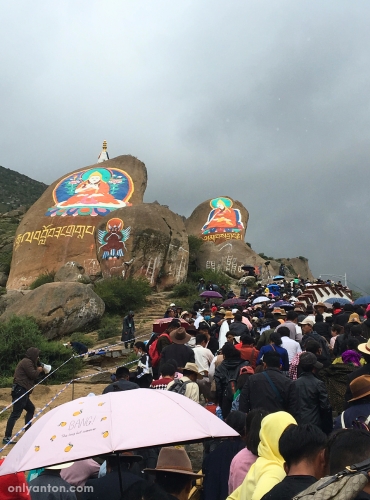
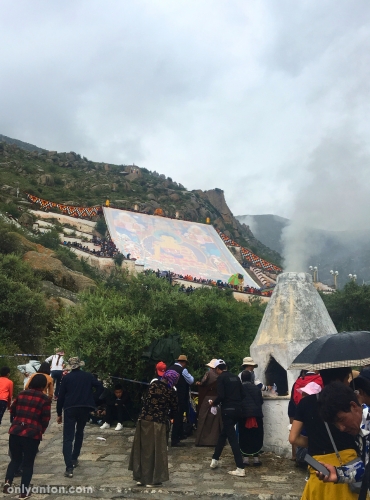
Thangka paintings are more than art; they are spiritual icons and educational tools. During the Shoton Festival, these paintings transcend their material form. The Thangka becomes a medium through which the divine communicates, offering blessings to the beholders. Yet another powerful gesture of reverence is the tossing of prayer scarves (hada) onto the Thangka . It is a powerful gesture of reverence and a visually poignant moment, symbolizing the collective faith of the pilgrims.
Personal Pilgrimage
My personal pilgrimage to the Thangka was a deeply moving experience. Venturing ahead of my tour group, I engaged with locals in my rudimentary Mandarin, sharing smiles and selfies. This personal connection added a unique dimension to my spiritual journey. Prayerful chants and the scent of incense lined the path to the Thangka. Eventually, it led me to a plateau where a serene yet vibrant scene of prayer and devotion unfolded before me.

The strong spiritual bond that the festival fostered among all of us present struck me as it was coming to an end. The Shoton Festival, with its rituals and the majestic Thangka, is a profound expression of Tibetan Buddhism’s vibrancy and enduring cultural heritage. It’s a festival that celebrates the end of seclusion for monks. However, it also reaffirms communal ties through shared spiritual rejuvenation, fostering a sense of belonging and shared experience.
Prayer Wheels
In Lhasa, Tibet, prayer wheels line the streets surrounding significant religious sites like the Jokang Temple and the Potala Palace. These prayer wheels, or cylinders, hold profound religious and spiritual significance in Tibetan Buddhism. They embody deep-rooted traditions and beliefs and play a crucial role in Tibetan Buddhist practices.
One of the most significant aspects of Tibetan Buddhism is the role of prayer wheels. Spinning these cylindrical structures, often containing the Om Mani Padme Hum mantra, transmits prayers into the surrounding environment. Buddhists view this continuous prayer as a way to accumulate spiritual merit. The sincere act of spinning the wheel with a pure heart brings about positive karma and contributes to spiritual progress.
The prayer wheels are also associated with wish fulfillment. Individuals often turn them with specific intentions or wishes, hoping for positive outcomes and the fulfillment of their desires. This act is part of circumambulation (kora), a ceremonial act of moving or walking around sacred sites. In Tibetan Buddhism, circumambulation proceeds in a clockwise direction. The chanting of mantras and the counting of prayer (mala) beads are frequent accompaniments to this type of walking meditation. Some Buddhist faithful go so far as to prostrate themselves at every step.
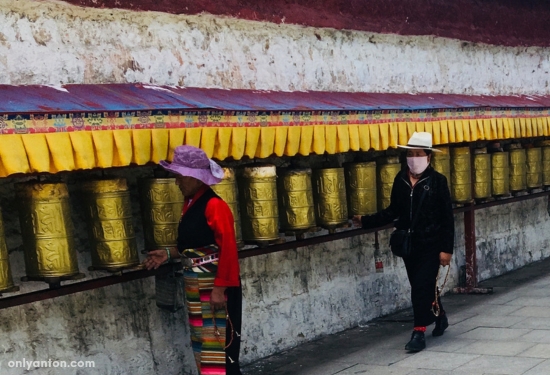
Spinning the prayer wheels is also believed to purify the environment. Each turn of the wheel dispels negative energies and brings blessings and positive energy to the surroundings. This collective practice fosters a sense of community and reinforces the spiritual identity of the region. Overall, the prayer wheels serve as tangible instruments for expressing faith. By this means. practitioners engage in continuous prayer, accumulate merit, and participate in the spiritual vibrancy of Lhasa, Tibet.
Jokhang Temple
Nestled in the heart of Lhasa, Tibet, the Jokhang Temple stands as a testament to Tibetan Buddhism’s rich history and spiritual significance. King Songtsen Gampo constructed the temple in the 7th century. Today, it is revered as one of Tibet’s oldest and most important religious sites.
The Jokhang Temple’s architecture uniquely blends Tibetan, Indian, and Nepalese styles. Its wooden and stone structures feature intricate carvings and decorative elements. The temple serves as the spiritual centre of Lhasa. It is a focal point of Tibetan pilgrimage, drawing pilgrims from all corners of Tibet and beyond.
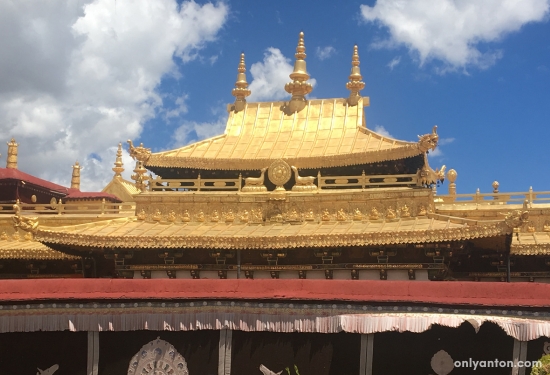
The Jowo Rinpoche, a life-sized statue of the young Buddha thought to have received blessings from Buddha Sakyamuni himself, is one of the most revered features of the Jokhang Temple. The temple’s main hall houses various chapels and statues, where pilgrims perform circumambulation as a form of devotion.
The Jokhang Temple is a UNESCO World Heritage Site and part of the “Historic Ensemble of the Potala Palace.” Surrounding the temple is Barkor Street, a famous pilgrimage circuit. The temple hosts various religious ceremonies and festivals throughout the year, highlighting its cultural and spiritual significance.
The Jokhang Temple has faced numerous challenges throughout its long history, including renovations and restorations. Nevertheless, it remains a symbol of Tibetan Buddhism’s endurance and spiritual resilience. A visit to this sacred site offers a profound experience. It allows individuals to immerse themselves in the rich tapestry of Tibetan Buddhism and its deep-rooted cultural heritage.
Potala Palace
The Potala Palace is an iconic symbol of Tibetan culture and spirituality. This majestic architectural marvel sits atop Marpo Ri (Red Hill) and offers panoramic views of the Lhasa Valley. Originally, King Songtsen Gampo built the palatial structure in the 7th century. The fifth Dalai Lama commissioned the current building, which dates to the 17th century.
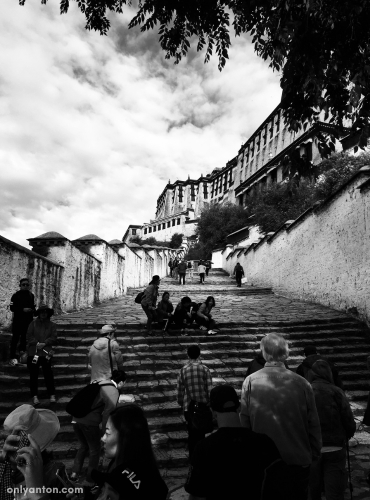
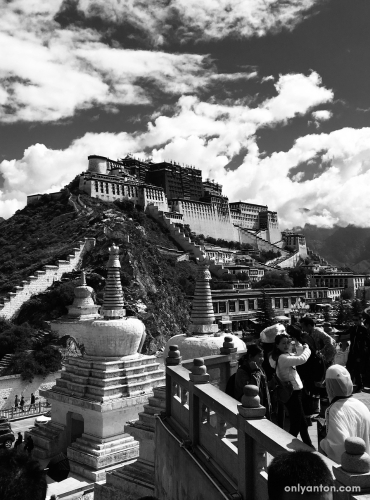
As the Dalai Lama’s Winter Residence, the palace was crucial for religious and political activities. It was a palpable reflection of the fusion of spiritual and political power. The complex includes the Red Palace and the White Palace. The Red Palace houses the sacred stupa tomb of the fifth Dalai Lama. The White Palace served as the Dalai Lama’s living quarters.
Like Jokhang Temple, the palace is a UNESCO World Heritage Site. This cultural and historical treasure is famous for its unique Tibetan architecture, which blends Tibetan, Indian, and Nepalese styles. Intricate murals, thangkas, sculptures, and other artistic treasures adorn the palace interior. Taken together, they depict Tibetan Buddhist cosmology, religious teachings, and historical events. Today, the palace attracts tourists and pilgrims worldwide, offering a glimpse into Tibet’s rich history, spirituality, and cultural legacy.
Insights and Reflections
My experience of Tibetan culture during the Shoton Festival and the pilgrimage to witness the Thangka painting offered a profound insight into the region’s rich spiritual and cultural heritage. It transcended mere sightseeing. It allowed a glimpse at the deeper essence of Tibetan Buddhism and the way of life in this remote corner of the world.
Deep Spirtuality
One striking aspect of this journey was the deep sense of spirituality that permeates every aspect of Tibetan culture. From the intricate rituals of the Shoton Festival to the daily practices of pilgrims spinning prayer wheels and prostrating themselves along Barkhor Street, Tibetans’ devotion to their faith is palpable. This spiritual devotion is not just a personal endeavour but a communal one. Entire communities come together to celebrate their beliefs and reaffirm their cultural identity.
Tibetan Resilience
This journey was an opportunity to witness the resilience of Tibetan culture in the face of modernity and change. Despite centuries of political upheaval and external pressures, Tibetans have managed to preserve their unique way of life. They have kept alive ancient traditions and customs that date back thousands of years. This resilience is most evident in the spiritual heart of Tibet, Lhasa. The ancient monasteries and temples stand as a testament to the enduring power of faith and tradition.
Local Engagement
One of the most meaningful experiences of this journey was the opportunity to engage with the local Tibetan people. Their warmth, hospitality, and spiritual depth left a lasting impression. Whether sharing a traditional Tibetan breakfast in a humble hut or chatting with monks in a centuries-old monastery, these interactions offer a glimpse into a way of life deeply rooted in tradition yet open to the world.
Overall, a journey through Tibet is not just a physical adventure. It is a spiritual and cultural odyssey that challenges preconceptions and expands horizons. It offers profound insights into the nature of faith, the resilience of culture, and the beauty of human connection.
Conclusion
In conclusion, my journey through Lhasa, Tibet, had been nothing short of transformative. The Shoton Festival, the serene spirituality of the Jokhang Temple, and the majestic beauty of the Potala Palace. Each of these experiences has left an indelible mark on me.
Through these experiences, I’ve realized the profound impact of cultural immersion and travel on our lives. Travel is not just about seeing new places. It’s about opening our minds and hearts to new ways of thinking and being. It’s about connecting with others meaningfully, transcending language and cultural barriers to find common ground.
My time in Lhasa taught me the value of patience, presence, and humility in the face of the unknown. It has shown me that true understanding comes not from seeking to change others. It comes from embracing our differences and celebrating our shared humanity. In the process, you end up changing yourself.
As you embark on your own adventures, I encourage you to approach each new experience with an open mind and a compassionate heart. Seek out the beauty in diversity, and let it enrich your life in ways you never thought possible. Travel has the power to transform us, broaden our horizons, and remind us of our world’s beauty and wonder. Embrace it thoroughly, and let it change you for the better.
What about you?
Your voice is not just welcome. It’s integral to the Only Anton community. I invite you to share your own cultural travel experiences. Whether you’ve experienced the vibrant traditions of Tibet or explored other corners of the globe, your stories have the power to inspire and connect us all. Share your insights, reflections, and meaningful encounters in the comments below. I can’t wait to hear your stories.
Additionally, I urge you to engage with this post by leaving a comment or joining the discussion. Share your thoughts and perspectives on the aspects of Tibetan culture that resonated with you. Or share similar experiences from your travels. They can enrich our understanding and appreciation of the world. Your contribution is significant, and I look forward to hearing from you.
If you’re craving more cultural adventures, the ‘Think’ category on the Only Anton blog is your gateway. It’s a space where philosophy, travel, and cultural exploration intersect. Here, you can discover new perspectives, challenge your assumptions, and embark on a journey of self-discovery through the lens of travel. Your next adventure is just a click away, and I’m here to be your guide.
Further Reading
To learn more about the activities described above in Lhasa, Tibet, take a look at some of the following resources:
- Lonely Planet, “Lhasa”: Click here to see Lonely Planet’s guide to must-see attractions in Tibet’s capital.
- Lonely Planet, “Jokhang Temple”: Click here to find Lonely Planet’s description of Jokhang Temple and suggestions for nearby attractions.
- UNESCO World Heritage Centre, “Historic Ensemble of the Potala Palace, Lhasa”: Extensive information about the Potala Palace can be found here.
- National Geographic, “Discover Tibet’s Breathtaking Palace in the Clouds,” (August 29, 2018), by Clarissa Wei: The informative article can be read online here.
- Norbulingka Institute of Tibetan Culture, “Painted Thangkas”: Some beautiful examples of thangkas may be seen here.
- Christie’s, “Collecting Guide: Himalayan paintings,” (March 26, 2024) by Hannah Perry: An in-depth explanation of these religious paintings can be found here.
- Wikipedia, “Sho Dun Festival”: a brief explanation of the Shoton festival can be seen here.
- Wikipedia, “Prayer wheel”: A fuller explanation of prayer wheels can be seen here.
- Tibet Vista, “Shoton Festival Tour”: This travel agency has not paid me. Nevertheless, it is the tour group I used for my trip to Tibet. I had a great experience with this company, although you have many other choices as well. To see an example of a tour to the Shoton Festival, click here.
To read more about Tibet, check out some of my other blog posts:
- Tibetan Trek to Everest Base Camp: Patience and Presence at the Roof of the World




